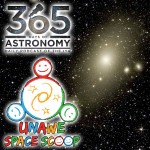Podcaster: Richard Drumm
 Title: Space Scoop: Greedy Galaxies
Title: Space Scoop: Greedy Galaxies
Organization: 365 Days Of Astronomy
Link : astrosphere.org ; http://unawe.org/kids/unawe1530/
Description: Space scoop, news for children.
Bio: Richard Drumm is President of the Charlottesville Astronomical Society and President of 3D – Drumm Digital Design, a video production company with clients such as Kodak, Xerox and GlaxoSmithKline Pharmaceuticals. He was an observer with the UVa Parallax Program at McCormick Observatory in 1981 & 1982. He has found that his greatest passion in life is public outreach astronomy and he pursues it at every opportunity.
Today’s sponsor: This episode of “365 Days of Astronomy” is sponsored by — no one. We still need sponsors for many days in 2015, so please consider sponsoring a day or two. Just click on the “Donate” button on the lower left side of this webpage, or contact us at signup@365daysofastronomy.org.
Transcript:
This is 365 Days of Astronomy. Today we bring you a new episode in our Space Scoop series. This show is produced in collaboration with Universe Awareness, a program that strives to inspire every child with our wonderful cosmos.
Today’s story is…
Greedy Galaxies
Galaxies are collections of hundreds of billions of stars. But did you know that some galaxies grow even bigger by gobbling up smaller galaxies?
Astronomers have believed this for a while, but it’s been very difficult to prove. Once a galaxy has been eaten, it’s almost impossible to find any evidence that it ever existed.
It’s like looking for water thrown from a bucket into a pond. The water very quickly becomes part of the pond leaving no trace.
In the same way, stars from the smaller galaxy slip into the larger galaxy and it becomes almost impossible to tell which stars originally belonged to which galaxy.
But astronomers have now come up with a very clever way to spot a galaxy that has been eaten. They look at clouds of cosmic gas and dust called planetary nebulae.
A planetary nebula (or PN for short) forms when a Sun-like star reaches the end of its life. PNs emit a large fraction of their energy in just a few spectral lines, the brightest of which, called OIII or oxygen 3, is in the green part of the spectrum.
Because of the green color of that so-called “doubly ionized” oxygen, PNs can be spotted more easily than individual stars, by simply using a green OIII filter that lets through the 2 green colors that OIII gas emits.
The green filter makes the white light of the more numerous other stars dimmer, increasing the contrast of the PNs and making them stand out like the proverbial sore thumb!
PNs last a relatively short time, just a few tens of millions of years, so there aren’t very many of them compared to the stars they come from, which last for billions of years.
Now, imagine throwing that bucket of water into the pond again. But this time the water in your bucket is muddy. When the water joins the pond, we can still see floating pieces of mud moving among the ripples on the surface.
The planetary nebulae act like the mud particles and show us the remnants of the small galaxy moving through the bigger galaxy.
This technique has been used on a famous supergiant elliptical galaxy called Messier 87 in the constellation Virgo. That’s it in today’s album artwork. An elliptical galaxy forms when spiral galaxies collide and their intricate spiral structure is disturbed and averaged out.
They look like smooth, featureless ellipsoids that aren’t flat any more like the spiral galaxies they formed from. They look kind of like a football or rugby ball. These aged galaxies have very little gas in them and are no longer forming many stars.
Astronomers looked at 300 planetary nebulae inside this galaxy and found that it has a dark secret. It has swallowed an entire spiral galaxy at some point over the last billion years!
Hey, Here’s a Cool Fact:
Trying to spot one planetary nebula in Messier 87 is the same as trying to spot two normal 60-watt light bulbs on Venus from here on Earth!
Thank you for listening to 365 Days of Astronomy!
End of podcast:
365 Days of Astronomy
=====================
The 365 Days of Astronomy Podcast is produced by NUCLIO. Audio post-production by Richard Drumm. Bandwidth donated by libsyn.com and wizzard media. You may reproduce and distribute this audio for non-commercial purposes. Please consider supporting the podcast with a few dollars (or Euros!). Visit us on the web at 365DaysOfAstronomy.org or email us at info@365DaysOfAstronomy.org. This year we celebrate cosmic light as light is our info messenger in the universe. Join us and share your story to celebrate the International Year of Light. Until tomorrow! Goodbye!

